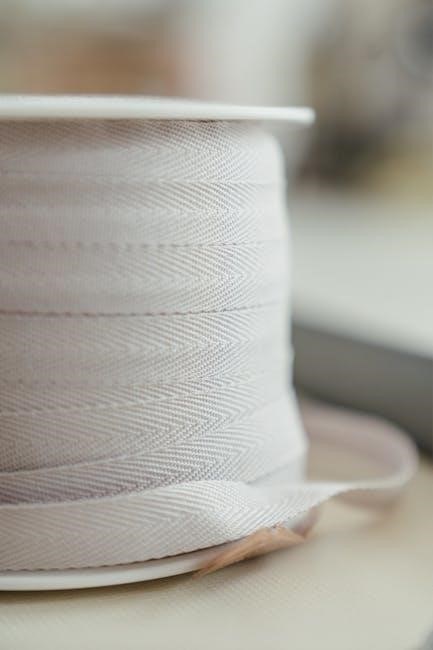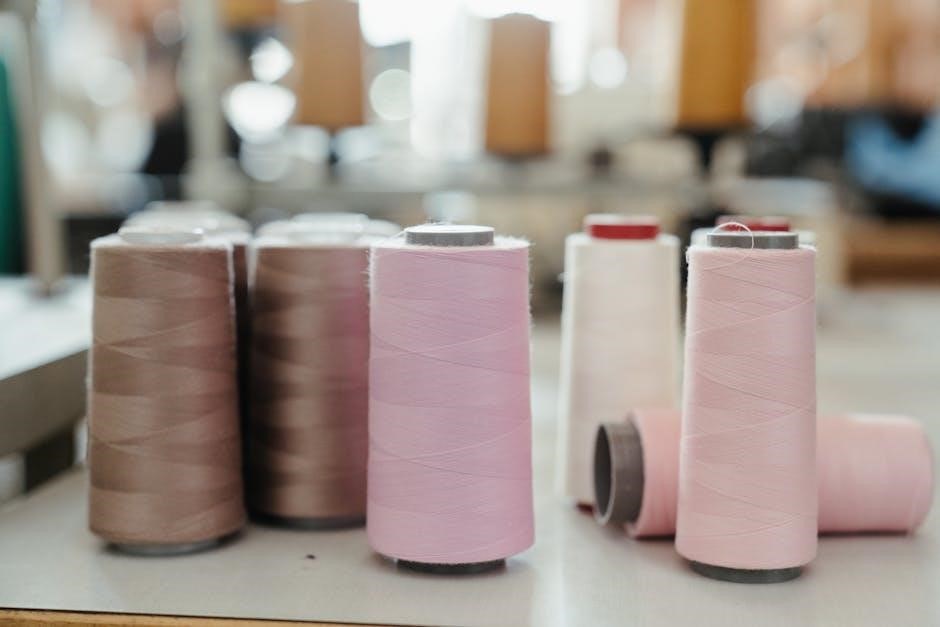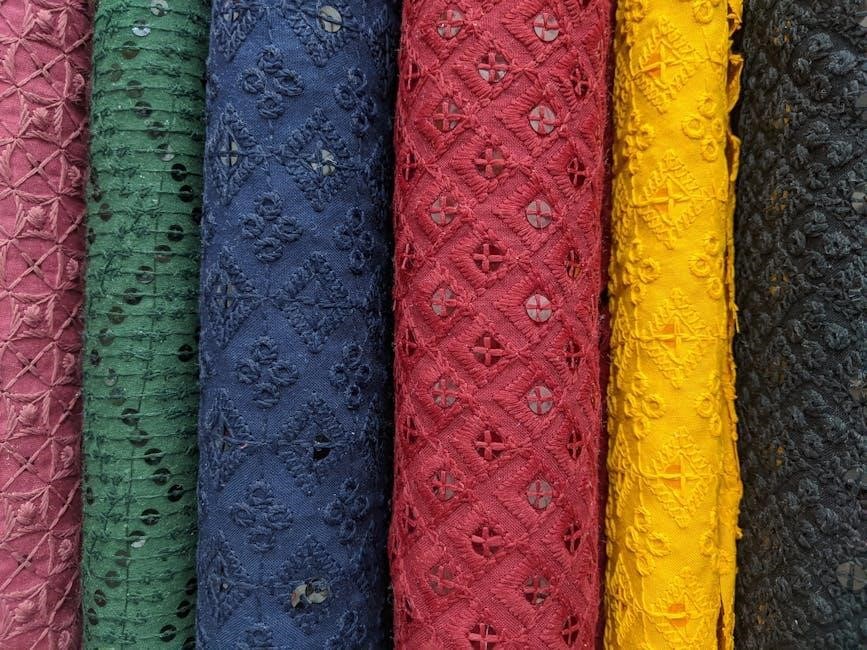Jelly Roll quilt patterns offer a fun and efficient way to create stunning quilts using pre-cut fabric strips. Perfect for beginners and experienced quilters, these patterns are versatile, time-saving, and widely available as free PDF downloads.
What is a Jelly Roll?
A Jelly Roll is a collection of pre-cut fabric strips, typically 2.5 inches wide and 44 inches long, rolled into a convenient bundle. Coined by Moda, it usually contains 40 strips, offering a variety of colors and prints from a single fabric collection. The name “Jelly Roll” comes from its resemblance to a swirled jelly roll cake when the strips are rolled together. These pre-cut strips are designed to simplify quilting projects, allowing quilters to skip the fabric-cutting step and focus on sewing. Jelly Rolls are ideal for creating vibrant, cohesive quilts quickly and efficiently. Their uniform width makes them perfect for various quilt patterns, from traditional designs like Rail Fence to modern twists. Whether you’re a beginner or an experienced quilter, Jelly Rolls provide endless creative possibilities while saving time and effort.
Understanding Jelly Roll Quilt Patterns
Jelly Roll quilt patterns are designed to maximize the use of pre-cut fabric strips, making quilting faster and more accessible. These patterns leverage the uniform 2.5-inch width of Jelly Roll strips, allowing for seamless integration into various quilt designs. From simple to complex layouts, Jelly Roll patterns cater to all skill levels, offering versatility in design and size. Many patterns are available as free PDF downloads, providing quilters with easy access to creative projects. The strips’ consistent width enables precise alignment and stitching, reducing the need for intricate cutting. This accessibility makes Jelly Roll patterns ideal for beginners while still appealing to experienced quilters seeking efficient projects. The variety of patterns ensures that quilters can explore traditional and modern designs, creating everything from baby quilts to bed-sized masterpieces. With Jelly Roll patterns, the focus shifts from cutting fabric to enjoying the sewing process, fostering creativity and productivity.

Popular Types of Jelly Roll Quilt Patterns
Jelly Roll quilt patterns offer a variety of stunning designs, including Coins and Bars, Rail Fence, Log Cabin, Zig Zag, and Modern Twists, catering to all skill levels and creative preferences.

Coins and Bars Patterns
Coins and Bars patterns are timeless favorites in Jelly Roll quilting, offering simplicity and versatility. These designs showcase pre-cut strips in a straightforward yet visually appealing arrangement. The “Coins” pattern features circular or oval shapes created by sewing strips together, while “Bars” involve arranging strips in linear segments. Both styles are perfect for beginners, as they require minimal seams and allow for quick completion. The repetitive nature of these patterns makes them meditative and rewarding, ideal for quilters of all skill levels. With free PDF guides widely available, you can easily download and start your project. These patterns are also adaptable, allowing you to create anything from baby quilts to lap throws. The key to success lies in fabric selection, as contrasting colors and prints can elevate the design from classic to contemporary.
Rail Fence and Log Cabin Designs
Rail Fence and Log Cabin designs are beloved Jelly Roll quilt patterns that offer classic charm and simplicity; The Rail Fence pattern involves sewing Jelly Roll strips horizontally and vertically to create a checkerboard-like design, while the Log Cabin pattern builds around a central square, adding strips to form a cabin-like structure. Both designs are perfect for showcasing fabric collections and work well with Jelly Roll strips due to their repetitive, strip-based construction. These patterns are ideal for quilters of all skill levels, as they require minimal cutting and sewing. Free PDF guides for these designs are widely available, making it easy to get started. Rail Fence quilts are great for creating a modern, geometric look, while Log Cabin quilts often carry a traditional, homespun feel. Both patterns can be customized with various fabric combinations and sizes, making them versatile for any project, from baby quilts to bed-sized masterpieces.
Zig Zag and Modern Twists
Zig Zag and Modern Twists bring a fresh, contemporary spin to Jelly Roll quilt patterns. These designs feature dynamic, angular layouts that create visually striking quilts with a modern aesthetic. The Zig Zag pattern is particularly popular, as it uses Jelly Roll strips to create a sense of movement and energy. By arranging the strips at angles or in alternating directions, quilters can achieve a bold, trendy look. Modern Twists often incorporate asymmetrical designs, bold colors, and creative layouts, making them perfect for those looking to step away from traditional styles. These patterns are great for showcasing vibrant fabric collections and can be adapted to various sizes, from lap quilts to bed-sized projects. Free PDF guides for these designs are widely available, offering step-by-step instructions and inspiration. Video tutorials also provide helpful guidance, making it easy for quilters of all skill levels to explore these innovative patterns and add a modern flair to their creations.

Benefits of Using Jelly Roll Quilt Patterns
Jelly Roll quilt patterns offer time-saving convenience with pre-cut strips, available as free PDF downloads. They provide versatility for various quilt sizes and creative designs, perfect for both beginners and experienced quilters.
Time-Saving with Pre-Cut Strips
One of the most significant advantages of Jelly Roll quilt patterns is the time-saving benefit of using pre-cut fabric strips. These strips, typically 2.5 inches wide and 44 inches long, eliminate the need to cut fabric from scratch. With a Jelly Roll, you can immediately start sewing, making the process faster and more efficient. The uniform width of the strips ensures consistency in your design, reducing the risk of measurement errors. This convenience is especially appealing for beginners who want to focus on sewing techniques rather than fabric preparation. Additionally, the pre-cut strips allow for quick project completion, making Jelly Roll quilts ideal for those with busy schedules or for last-minute gifts. Many free PDF patterns are designed to maximize the use of these strips, offering step-by-step guides to help quilters of all skill levels create beautiful projects effortlessly. This time-saving feature has made Jelly Roll quilts a favorite among both hobbyists and professional quilters.
Versatility in Design and Size
Jelly Roll quilt patterns are celebrated for their incredible versatility, catering to a wide range of creative visions and project sizes. Whether you’re crafting a cozy baby quilt, a lap blanket, or a full-size bed quilt, Jelly Roll strips can be easily adapted to fit your needs. The pre-cut strips allow for endless design possibilities, from traditional layouts like Rail Fence and Log Cabin to modern interpretations such as Zig Zag patterns. Many free PDF patterns feature adjustable sizing options, enabling quilters to customize the project according to their preferences or the intended use. This adaptability makes Jelly Roll quilts suitable for various occasions, such as gifts, home decor, or personal projects. Moreover, the ability to mix and match strips from different Jelly Rolls opens up opportunities for unique and personalized designs, ensuring that no two quilts are alike. This versatility has made Jelly Roll quilts a popular choice for quilters seeking flexibility and creativity in their work.

Tools and Materials Needed

Essential tools include a sewing machine, rotary cutter, and mat. Materials like Jelly Rolls, coordinating fabrics, and batting are required. Free PDF patterns often provide detailed lists for easy preparation.

Necessary Tools for Jelly Roll Quilting
To successfully create Jelly Roll quilts, you’ll need a few essential tools. A high-quality sewing machine is a must, along with a rotary cutter, cutting mat, and ruler for precise fabric cutting. An iron and ironing board are crucial for pressing seams. Additionally, sharp scissors, pins, and a seam ripper are handy for minor adjustments. A quilting needle and thread set is also necessary for piecing and stitching. For accuracy, consider using a walking foot or even feed foot on your sewing machine. Many free Jelly Roll quilt patterns include detailed tool lists, ensuring you’re well-prepared. Optional tools like a quilting frame or AccuQuilt cutter can enhance efficiency but aren’t required for basic projects. Organizing your tools and materials beforehand will streamline the quilting process.
Fabric Requirements and Strip Organization
Jelly Roll quilting typically requires pre-cut fabric strips, each 2.5 inches wide and 44 inches long, bundled into a “roll” of 40 strips. These strips are perfectly coordinated, offering a variety of colors and patterns from a single fabric collection. For most patterns, one Jelly Roll is sufficient for a small quilt, while larger projects may need two or more rolls. If you prefer, you can substitute Jelly Roll strips with 2.5-inch strips cut from your own fabric stash. Organization is key: sort strips by color, pattern, or texture to ensure a cohesive design. Many free PDF patterns include strip organization tips to maximize fabric efficiency. Proper planning and sorting of strips will streamline the quilting process and enhance the final result. Always refer to the specific pattern for exact fabric requirements, as they may vary depending on the design and size of the quilt.

Free Jelly Roll Quilt Pattern Resources
Discover a wide variety of free Jelly Roll quilt patterns available as downloadable PDFs. Websites like Fat Quarter Shop and Moda Bake Shop offer an array of designs, from simple to intricate, perfect for all skill levels.

Top Websites for Free PDF Downloads
Several websites provide an extensive collection of free Jelly Roll quilt patterns in PDF format. Fat Quarter Shop offers exclusive designs like the Jelly Roll Jam Shortcut Quilt, perfect for quick projects. Moda Bake Shop features patterns that highlight pre-cut strips with creative layouts. Meanwhile, The Jolly Saber offers free PDF guides and video tutorials, making it easier for quilters to follow along. Additionally, sites like Lella Boutique and Hello Sewing curate lists of free Jelly Roll patterns, including modern and traditional designs. These resources cater to all skill levels, ensuring quilters can find patterns that suit their preferences and project goals. With these websites, accessing high-quality, free Jelly Roll quilt patterns has never been more convenient.
Video Tutorials and Guides
Video tutorials and guides are invaluable resources for quilters looking to master Jelly Roll quilt patterns. Websites like The Jolly Saber and Fat Quarter Shop offer comprehensive video tutorials that complement their free PDF patterns, providing step-by-step instructions for various projects. These tutorials are perfect for beginners, as they demonstrate techniques like strip piecing, seam alignment, and binding. Additionally, platforms like YouTube and Hello Sewing feature a wide range of Jelly Roll quilt tutorials, covering designs from simple coins and bars to complex zigzag patterns. Many tutorials also include tips for organizing strips, reducing fabric waste, and adding modern twists to traditional designs. Whether you’re making a baby quilt or a full-size bed quilt, these video guides ensure a smooth and enjoyable sewing experience. They are especially helpful for visual learners, making the process of creating stunning quilts with pre-cut strips more accessible and fun.

Design Ideas and Inspiration
Jelly Roll quilt patterns inspire creativity with their versatility, offering traditional and contemporary designs. From baby quilts to scrap quilts, these patterns spark imagination, allowing quilters to craft unique, stylish projects with ease and flair.
Traditional vs. Contemporary Designs
Traditional Jelly Roll quilt designs often feature classic patterns like Rail Fence and Log Cabin, which emphasize simplicity and timeless appeal. These designs typically use strip piecing to create cohesive, symmetrical layouts that reflect heritage quilting techniques. On the other hand, contemporary designs incorporate modern twists, such as bold color combinations, asymmetrical layouts, and innovative block arrangements. These patterns often blend traditional strip piecing with fresh, trendy aesthetics, making them ideal for those who want to push creative boundaries. Both styles leverage the convenience of pre-cut Jelly Roll strips, allowing quilters to explore a wide range of artistic expressions. Whether you prefer the charm of the past or the innovation of the present, Jelly Roll quilt patterns offer something for every quilter’s taste and skill level.
Baby Quilts and Small Projects
Jelly Roll quilt patterns are perfect for creating adorable baby quilts and small projects. These patterns are ideal for beginners, as they require minimal fabric and time while offering a variety of creative possibilities. Many free PDF patterns are specifically designed for baby quilts, such as the popular Jelly Roll Posies pattern, which uses pre-cut strips to create a charming and colorful design. Small projects like bibs, burp cloths, and diaper bags can also be made using Jelly Roll strips, making them great for quick gifts or personal use. The pre-cut strips save time on cutting and allow for a wide range of design options, from simple to intricate. Whether you’re making a cozy baby quilt or a practical small item, Jelly Roll patterns offer a fun and efficient way to sew meaningful projects.
Scrap Quilts and Creative Uses
Jelly Roll quilt patterns are a fantastic way to utilize scrap fabric and explore creative projects. These pre-cut strips allow quilters to craft unique and vibrant scrap quilts without the hassle of cutting fabric from scratch. Many free PDF patterns are designed to highlight the diversity of Jelly Roll strips, enabling quilters to create stunning, one-of-a-kind designs. Beyond quilts, Jelly Rolls can be used for creative projects like bags, rugs, and home decor items. Patterns such as Hexaround and Jelly Roll Sizzle offer innovative ways to repurpose scraps into beautiful, functional pieces. Whether you’re aiming for a traditional scrap quilt or a modern twist, Jelly Roll strips provide endless possibilities. This approach is perfect for quilters who enjoy experimenting with colors and textures while minimizing fabric waste.
Jelly Roll quilt patterns offer a fun, efficient, and creative way to craft beautiful quilts and projects. With pre-cut strips, quilters can save time while exploring a variety of designs, from traditional to modern. The availability of free PDF patterns makes these projects accessible to everyone, whether you’re a beginner or an experienced sewer. Jelly Roll quilts are perfect for using scrap fabric, reducing waste, and creating unique, personalized designs. Their versatility allows for projects of all sizes, from baby quilts to full-bed quilts, as well as home decor items like bags and rugs. The wide range of free resources, including tutorials and guides, ensures that quilters can always find inspiration and support. Jelly Roll quilting is not only a practical hobby but also a rewarding way to express creativity and produce meaningful, handmade items for yourself or as gifts.





